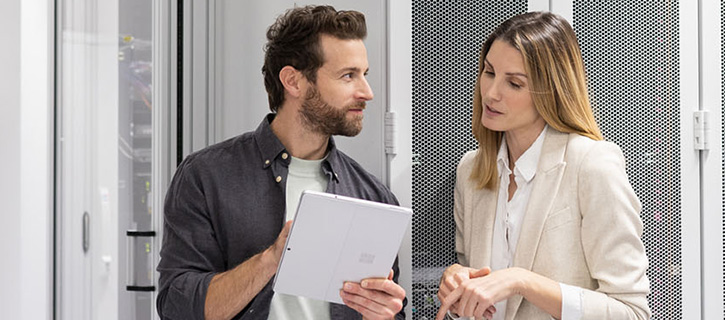In the first consultation meeting, we’ll be happy to show you how we can plan and realise your tailored security concept.

Security.
Protect your business from all kinds of risks and attacks.
The number of cyberattacks is continually rising and all the while, IT resources are being squeezed. IT security is much more than encryptions and malware protection. Companies are facing the challenge of protecting important data and systems and aligning them with data protection and other regulations. IT security forms the basis of this and needs to be included in every company’s strategic plans. What steps should you be taking now to best protect your business?
The digital transformation is changing business and technical processes, as well as the way people work. Employees want to be able to access data and applications from anywhere, but this opens the door to potential attacks. However, with the right partner by your side, you can approach the topic of IT security with peace of mind. We understand your challenges in this turbulent world and live modern IT security. We are by your side every step of the way to a modern security strategy.
The benefits of our holistic approach at a glance:

Increased IT security.
All security-critical measures are in tune with each other and inextricably linked for maximum protection.

Internal resources are freed up.
Harmonised measures simplify everyday work. The aim: more time for every day business.

Easier to manage.
Communicating with Bechtle instead of different vendors.

People, processes and technologies are unified.
High quality security measures enable secure working and access from any location.

Quick reactions.
React without delay to unusual activities in your network with our Managed Services.

Goodbye hodgepodge.
Standalone solutions aren’t often designed to work together and can therefore become potential gateways for attackers. We uncover your network’s vulnerabilities.
Overarching security:
Bechtle’s 360° solution.
To achieve bulletproof security, you need an end-to-end solution that covers people, technology and processes and can be used in a variety of areas, no matter if that’s Industry 4.0, a classic IT infrastructure, network security, cloud solutions or mobile working.
The Bechtle 360° approach establishes an overarching cyber defence strategy consisting of different security solutions, regardless of whether a concept is needed for information security, network or end device security architectures, or if a Security Operation Centre (SOC) should be managed at the customer’s location or externally. Bechtle Security covers all aspects of IT security with its seven security practices to protect businesses and enabling you to detect threats early, analyse them and stop them in their tracks.
- Application security
- Cloud security
- Cyber crime & defence
- Data centre security
- Data protection and information security
- Infrastructure and perimeter security
- Workplace security
Bechtle is by your side, every step of the way:
Consultation, implementation, operation.
Security solutions should be planned and rolled out in line with ITIL principles.
The individual steps for this area are:
IT security – Plan.
Consultation is key. Based on a detailed analysis of requirements, the Bechtle consultants develop a solution tailored to the customer. Because more and more companies are amalgamating or relocating production locations, Bechtle has developed security architecture workshops. In these workshops, we develop solution scenarios together with the customer – such as how locations in various countries can be securely networked with one another – to give network security a boost.
IT security – Build.
Following consultation comes extensive planning and design in order to find the best IT security solution. Next, our system engineers roll out the required elements on-site with the customer. We document each individual implementation step and make these documents available. If the customer wants to operate the infrastructure themselves, they will receive a professional briefing from us. Alternatively, our Managed Service experts will gladly assume the operative tasks required for transition of your security solution.
IT security – Run.
Our Managed Security services offer you exactly the security solution your company needs – whether that’s on-site services or remote operation from one of our networking and security operation centres. We’ll find the best solution for you.
The benefits:
- 24/7 support
- Health and availability monitoring
- Backup & recovery
- On-site operational support
- Remote operation of (parts of) security infrastructures
- Outsourcing with operation responsibility: Remote, on-site or hybrid operation
- Security-monitoring, log analyses, cyber defence and threat intelligence
- Security incident management or as an integrated service as part of IT incident management

Since the European General Data Protection Regulation (GDPR) came into effect, businesses are legally required to comply with strict rules when it comes to protecting customer-data. And that means that they need to deal with an increasing amount of regulatory requirements and optimise their IT systems accordingly.
This is where Bechtle’s incident response and emergency management for crisis consultancy module comes into play, which illustrates how companies can, for example, properly react to a cyber-attack. In addition to your IT and security departments, we also involve important departments such as management, PR, marketing and legal in order to protect your company from reputation damage and financial losses.
IT security – What does it mean? A definition.
From the protection of single pieces of data and network security to cloud services and securing data centres, IT security must be considered extensively and holistically. All planning, measures and controls that serve to protect against attacks are all part of IT security, which is fundamental to compliance with the company. Our view of security is up to date and realistic, which is how we know that a hodgepodge of standalone solutions has had its day. Only an end-to-end approach can offer complete protection for your network. We will advise you on the central roles and necessary organizational measures.

We are by your side – Round the clock. Wherever you are.
We have over 200 security engineers and consultants taking care of our customers’ IT security and our certified security experts are constantly deepening their knowledge of all relevant technologies and topics. Our Competence Centres are specialised in securing IT systems and have a wealth of best practices they can fall back on. We have over 300 certifications in the area of security and work closely with more than 50 partner vendors. Benefit from our expertise and an end-to-end approach – all from a single source with Bechtle.

Traditional security concepts are based on the idea of maximum control through tactical partial solutions. In order to achieve a perceived higher level of security, administrators today put their faith in security solutions that don’t mesh, which often leads to security vulnerabilities. This, in turn, results in a complex infrastructure that is difficult to manage, causing performance restrictions and latencies, but in the course of digital transformation, IT security needs to be adapted to suit devices, data and applications. A harmonised solutions concept takes into account all aspects of an end-to-end security architecture.
* mandatory fields
Please read our Privacy Policy for information on how we process your data and protect your rights as a data subject.





